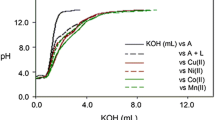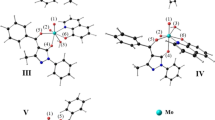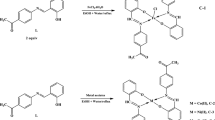Summary
New dioxomolybdenum(VI) complexes [MoO2LD] (LH2=Schiff base derived from isonicotinylhydrazide and salicylaldehyde, 2-hydroxynaphthaldehyde and 2-hydroxyacetophenone and benzoylhydrazide and 2-hydroxyacetophenone; D=H2O, HCONMe2, C5H5NO, C4H8O or Me2SO) have been synthesized and characterized. The complexes contain acis-MoO2 moiety. The difference betweenv sym andv asymm of MoO2 is related to the basicity and ligand repulsion of the ligand (L) and the donor power of D. All the complexes decompose before melting and their thermal stability is in the order: C4H8O < HCONMe2 < Me2SO < C5H5NO < H2O. The complexes are monomeric, non-electrolytes in solution in MeOH, MeCN and PhNO2 and are diamagnetic.
Similar content being viewed by others
References
E. I. Stiefel,Prog. Inorg. Chem., 22, 1 (1977) and refs. therein.
K, Dey, R. K. Maiti and J. K. Bhar,Transition Met, Chem., 6, 346 (1981).
A. Syammal and D. Kumar,Transition Met. Chem., 7, 113 (1982) and refs. therein.
A. Syamal and D. Kumar,Indian J. Chem., 21A, 534 (1982) and refs. therein.
A. Russel and L. B. Lockhart,Org. Synth., 22, 63 (1942).
A. I. Vogel,A Text Book of Quantitative Inorganic Analysis, 3rd. Edit., 1961, p. 508.
F. G. Mann and B. C. Saunders,Practical Organic Chemistry, Longmans, London, 1961, p. 435.
S. Sarasukutty and C. P. Prabhakaran,J. Inorg. Nucl. Chem., 39, 374 (1977).
A. Syamal and K. S. Kale,Indian J. Chem., 16A, 46 (1978).
K. Nagano, H. Kinoshita and A. Hirakawa,Chem. Pharm. Bull. (Tokyo),12, 1198 (1964);Chem. Abs., 62, 2758 (1965).
L. Sacconi and A. Sabatini,J. Inorg. Nucl. Chem., 25, 1389 (1963).
A. Braibanti, F. Dallavalle, M. A. Pellinghelli and E. Leporati,Inorg. Chem., 7, 1430 (1968).
F. A. Cotton and R. M. Wing,Inorg. Chem., 4, 867 (1965).
M. L. Larson and F. W. Moore,Inorg. Chem., 5, 801 (1966).
W. P. Griffith and T. D. Wickins,J. Chem. Soc.(A), 400 (1968).
G. C. Percy and H. S. Stenton,J. Chem. Soc., Dalton Trans., 2429 (1976).
K. Nakamoto,Infrared and Raman Spectra of Inorganic and Coordination Compounds, 3rd. Edit., 1978.
T. Miyazawa, T. Shimanouchi and S. Mizushima.J. Chem. Phys., 29, 611 (1958).
O. A. Rajan and A. Chakravorthy,Inorg. Chem. Acta, 37, L503 (1979).
E. I. Stiefel,Prog. Inorg. Chem., 22, 1977, p. 34.
Author information
Authors and Affiliations
Rights and permissions
About this article
Cite this article
Prabhakaran, C.P., Nair, B.G. Ligand function and substrate effect on metal-oxygen stretching frequencies in somecis-dioxomolybdenum(VI) complexes of bivalent tridentate Schiff bases. Transition Met Chem 8, 368–371 (1983). https://doi.org/10.1007/BF00618576
Received:
Issue Date:
DOI: https://doi.org/10.1007/BF00618576




